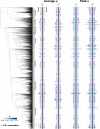Deep learning image segmentation reveals patterns of UV reflectance evolution in passerine birds
- PMID: 36038540
- PMCID: PMC9424304
- DOI: 10.1038/s41467-022-32586-5
Deep learning image segmentation reveals patterns of UV reflectance evolution in passerine birds
Abstract
Ultraviolet colouration is thought to be an important form of signalling in many bird species, yet broad insights regarding the prevalence of ultraviolet plumage colouration and the factors promoting its evolution are currently lacking. In this paper, we develop a image segmentation pipeline based on deep learning that considerably outperforms classical (i.e. non deep learning) segmentation methods, and use this to extract accurate information on whole-body plumage colouration from photographs of >24,000 museum specimens covering >4500 species of passerine birds. Our results demonstrate that ultraviolet reflectance, particularly as a component of other colours, is widespread across the passerine radiation but is strongly phylogenetically conserved. We also find clear evidence in support of the role of light environment in promoting the evolution of ultraviolet plumage colouration, and a weak trend towards higher ultraviolet plumage reflectance among bird species with ultraviolet rather than violet-sensitive visual systems. Overall, our study provides important broad-scale insight into an enigmatic component of avian colouration, as well as demonstrating that deep learning has considerable promise for allowing new data to be brought to bear on long-standing questions in ecology and evolution.
© 2022. The Author(s).
Conflict of interest statement
The authors declare no competing interests.
Figures





References
Publication types
MeSH terms
LinkOut - more resources
Full Text Sources

